The bronze doors of Bishop Bernward
Art is accorded a lot of significance in addressing the manner in which Biblical aspects are communicated and vital information preserved from one generation to another. The bronze doors at Bishop Bernward have images such as the one depicting God condemning Abraham and Eve after they had eaten the forbidden fruit.
The typological and thematic comparisons of the images on this door outline unique artistic features necessary in portraying the uniqueness of different works of art. In one of the images, Adam and Eve seem to be apportioning blame on the snake as their defense of their disobedience to God’s commandments. Cast in a single piece which is an extraordinary achievement, the doors have outstanding religious messages with the main themes aimed at either praising or condemning certain Biblical happenings.
The eight bar relief panels on the doors are symbolic in nature. The inclusion of the Biblical book of Genesis on the left and that of the life of Jesus Christ on the other right side of some of the images helps to communicate rich messages on the significance of the historical background and life of Jesus and his purpose for mankind. The symbolism on the doors of Bishop Bernward reveals the significance of the concept of baptism which is the sacrament that cleanses people’s sins.
Ghiberti’s bronze doors at the Florence Baptistery
The self portrait shown at the Baptistery East Door is seen to be moving outward with uniquely identified features that portray a man who is under hostage. The other image that features a group of people reveals the manner in which Joseph was captured and then put into imprisonment. The image portrays a sad scenario as it could be argued that the people in the image on the door convey connotations of slavery and the torture that Joseph underwent.
The original gilded-bronze panel doors depict the manner in which Joseph was tortured before finally being sold into slavery in a foreign land. The Ghiberti’s bronze doors at the Florence Baptistery are the best, most unique and outstanding of all the bronze doors of the time. They have in-depth color with little use of background shadows. The message communicated by the artistic message on the doors is very unique and conspicuous.
The bronze doors at the Florence Baptistery are described as the gates of the renowned city of paradise. The images provide vital complementary information on the meaning of religion and the significance of religious practices of the church in the contemporary society. The church is depicted as a gateway to heaven and thus gives a lot meaning on the relevance of the bronze doors.
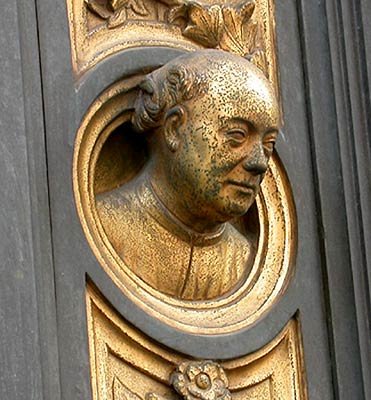

Ghiberti’s bronze doors at the Florence Baptistery: Image of Joseph being sold
Comparison and Contradiction
The fact that the two sets of doors are made of bronze is an indicator of the rich artistic nature of the people or culture behind the works. Though the concept of the shadow is not quite clear on the images on the Ghiberti’s bronze doors at the Florence Baptistery, the two sets of doors have utilized shadows to create a sense of depth. The sense of depth creates a strong feeling that the essence of distance is accorded due consideration in the images on the doors.



Images at the Bishop Bernward’s doors The Ghiberti’s bronze doors at the Florence Baptistery have images that are golden in color and with very outward looking images. The bronze doors of Bishop Bernward are dominated with dull colors with the images sometimes being overshadowed due to their small sizes. It is also evident that “negative space” is used on the images on the doors.
In both instances, the use of messages is scanty. Extremely little emphasis is laid on the use of messages, visual rhythm and imagery on the diverse images on the doors of Bishop Bernward. The doors also have a definite rift in the depiction of images. Repetition is another concept emphasized on the bronze doors of Bishop Bernward. Emphasis is laid on the need to bring out depth by ensuring that texts and images are small. This fact is evident on the doors that have images of God ostensibly addressing Adam and Eve.
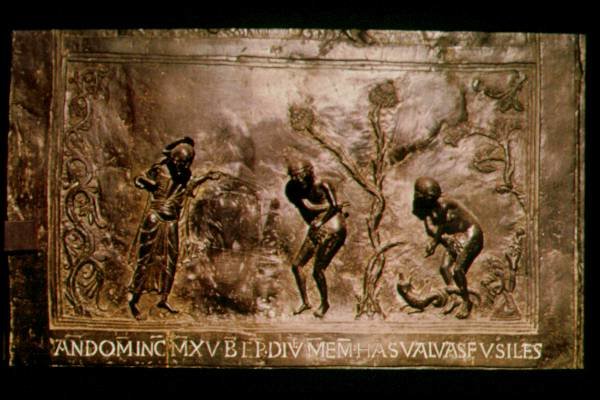
Bishop Bernward’s doors.
The rift between the images on the bronze doors of Bishop Bernward is palpable. One quality that lacks on the doors is uniform visual rhythm as certain doors are more lit than others. This fact is however not manifested on the doors that have the image of Joseph being sold as a slave since the use of shape, color, line, texture and the need for effective modeling of figures is accorded a lot of importance.
The bronze doors of Bishop Bernward effectively utilize gesture, symbolism and a lot of repetitive messages as is evidenced by the symbolic presentation of the cross by a hidden leaved cross on one of the doors.
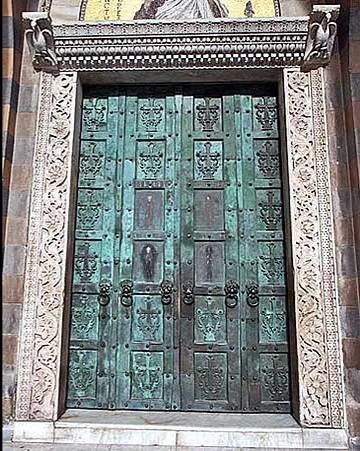

The bronze doors of Bishop Bernward
While the messages on the bronze doors of Bishop Bernward are extremely symbolic and difficult to decipher, the ones on the Ghiberti’s bronze doors at the Florence Baptistery are clearer, have outstanding and impressive messages and the modeling of figures is clear and with adequate gesture. The Ghiberti’s bronze doors are big in size with an impressive link between the “positive and negative spaces”. There is a major variation in depth of color and shadow in the two instances.
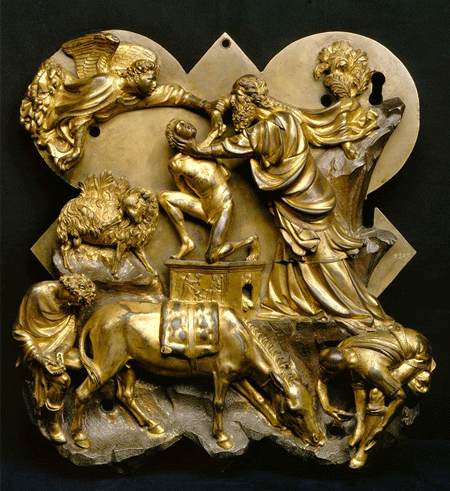
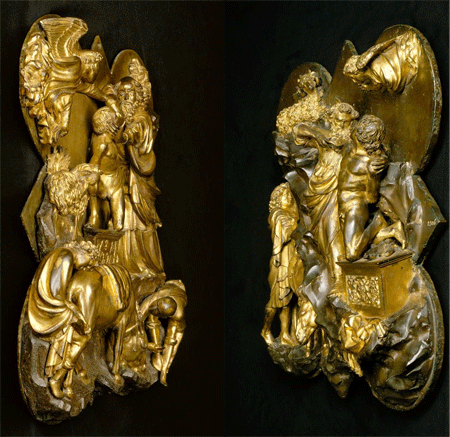
Ghiberti’s bronze doors at the Florence Baptistery
There is a unique yet very closely correlated stylistic composition and presentation of unique qualities that focus on enhancing the message contained on the doors of Bishop Bernward and those of the Ghiberti’s bronze doors. The images on both doors are mainly placed at the front section of the doors and are balanced in the manner in which images are aligned to the door frames.
While the two sets of doors are made of bronze, it is evident that the bronze doors of the Florence Baptistery reveal very striking innovations that definitely surpass the previous versions of the bronze doors including those at Bishop Bernward. The Ghiberti’s bronze doors at the Florence Baptistery have conservative motifs and outstanding compositional thoughts that are inherited from the cultural past of the medieval times.
Another similarity of the doors lies in the fact that in both cases, the elements between symmetry and hierarchy and symmetry and the notion of entry points to sacred places are the automatic single gateways to the much admired paradise. Both doors have a relatively similar composition of messages, images, related patterns of intersecting lines, uniform looping with a strong sense of energy and edges that border all individual scenes. Modeling of the figures on both doors has also been done though with varied intensity.